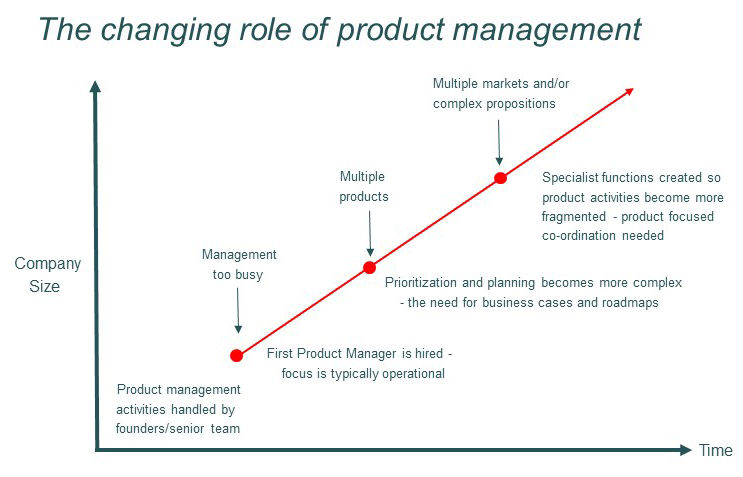
What’s your product manager role and why do you need to lead?
Well, do you find yourself ‘swimming with the shoal’? Your direction driven by whatever crisis you face? Busy, reacting to others around you?
In our recent industry survey, we found the average product manager spends 37% of their time dealing with unplanned issues.
We know that many product managers find this constant barrage of issues, criticism, and questions wearing. Their job satisfaction is low. They feel they’re never able to get ahead of the game.
But it’s what they, their colleagues and company have come to expect of the product manager role.
So what’s the answer?
We believe the answer is to make the product management role into one of leadership.
We want to outline exactly why strong leadership from product management can lead to better products, happier teams, and bigger profits. If you’re struggling to convince management that you should be taking the initiative and leading within the company, we want to give you the tools you need to form and prove your case.
So first let’s look at the changing role of product management as companies grow.
The changing role of product management

Product Manager Role
In start-ups and very small companies, it’s the founders who do the product management. The company only has one product and everyone lends a hand to get things done. But once companies start to grow there is a need for a product management function.
Small companies
As companies grow senior management gets involved in hiring, raising finance and managing people. They become very busy and can start to lose touch with what customers want and what’s going on in the market.
So eventually the decision is made to hire a product manager (PM) or more likely to promote someone from within the business into the role. With the founders breathing down the PM’s neck it may be difficult for them to see themselves as a leader. This is particularly true if the product manager role is seen as purely operational. The product manager is there to pick up all the things senior management doesn’t want to do e.g. writing detailed documentation, user guides, dealing with customer queries.
However, at this critical moment, product management can make an enormous difference if the role is also seen as a more strategic one. If the product manager is given the support and remit to thoroughly understand what customers and the market wants, then based on this knowledge they can provide credible input to lead both the product and company direction.
The truth is that many founders find it very difficult to let go of steering the product. It’s their little baby and they don’t want to let go. Taking on a leadership role as the first PM in a company takes courage, silky political skills, and a thick skin.
Companies with multiple products
As companies add more products the demands on product management change and shift. The need for the product manager role becomes more obvious as it becomes important to prioritize different product options and plan the best use of resources such as development teams and marketing budget. And it’s clear to everyone that senior management doesn’t have the time or interest to get involved with the details of each product.
Business cases and roadmaps are the tools of the product manager’s trade. Business cases are used to decide which product options to pursue. Roadmaps are used to align internal plans and help sell to B2B customers.
A key aspect of the product manager role is creating and managing virtual teams of people across the company all dealing with their own different aspects of the product. The role becomes about managing stakeholders, building relationships and influencing people. In summary, it becomes about providing a product focus and lead for the rest of the business.
Companies working with multiple products, complex propositions and a wide range of markets
As companies get even bigger with multiple products, multiple markets, and complex propositions – PMs face a widening set of challenges. Product activities typically become more fragmented across the business with specialist experts handling areas such as Pricing. Providing strategic direction, coordinating across multiple teams and maintaining a focus on driving the product forward becomes even more difficult. And as a result, product management becomes even more of a leadership role as competing agendas and conflicting priorities have to be balanced.
So how do you become a leader?
Most companies will welcome employees wanting to take on more responsibility. But they will be worried about promoting someone into the role without being sure they can deliver. So in many situations, you will have to demonstrate leadership before it is formally recognized. Reward (promotion or pay rise) follows commitment.
So here is our list of 6 tips to help you build your product manager role into one of leadership…
1. Have a product strategy and communicate it well
As a product manager, you don’t usually have direct control over the people you need to complete the job. ‘Virtual’ teams made up of different experts across the company are the norm.
Therefore, your ability to build effective working relationships and positively influence can determine your success. ‘Soft’ skills such as good communication are vital to this. However, being a leader is more than phone calls, active listening, and constructive meetings: you have to earn the right to lead.
To inspire others you need to have a product strategy. This should support the company objectives, explain the market context, where the product’s going and what’s key about the proposition. It should clarify and give direction, reassuring your team members and key stakeholders. Even if it’s just one slide – have something!
2. Focus as much on the market as you do on the product
Regularly engage with current and potential customers, scan the market and set up your network of listening posts. This helps you understand the motivations and challenges your target market face, what your customers need and what your competitors offer. Spotting trends and anticipating opportunities are vital to be able to set the direction of any product
It is known as becoming ‘the voice of the market’. You are the person within your company who is seen as the expert on your market. This will help you earn the right to be a leader for your product.
3. Be clear what product management stands for
Understand the primary goals of your function – why the company has a product management function.
For example, safeguarding product rule number 1 which is to ‘build once, sell many times’. Doing things in a repeatable, reusable way gives economies of scale and better profitability.
This applies when you develop the product but it is also a great approach for your product management activities. For example, try to standardize the processes and tools you use to streamline working practices. By ‘productizing’ product management in this way, you can save time, aid clarity and increase buy-in for your strategy.
Another goal is to balance the needs and demands of the product and customers against the needs of the company. You don’t need to be an expert on every aspect of the product, but you do need to be an expert on the overall view so you can weigh up the options and risks and make the right recommendations and decisions. Take a look at our Take Control Product Management Journal to learn more.
4. Clearly define the product manager role
Confusion about responsibilities and job boundaries is often an issue in product management. The product manager role is set up differently from company to company. As the term is used to describe a huge variety of roles in multiple industries, it can be difficult for team members and PMs themselves to know exactly what their roles entail.
To be successful, make sure conflict is minimized and ensure things are not missed – it is vital to provide clarity. Ensure everyone in your virtual team knows who does what and how they fit together. Our Product Activities Framework can help.
5. Use facts to back up your ideas
Good product management is based on facts and demonstrable results. This gives you credibility when battling to win over the senior stakeholders in your business.
You’ll get some of these facts from your network of listening posts but you should also make sure you have regular reporting in place for your product that shows how it is doing. Collecting quality metrics to back your views helps to win over upper management.
6. Have the support of those in power
In our most recent industry survey, we discovered 44% of Product Management teams were reporting directly to the board.
If you aren’t reporting directly to the top table, find a senior-level sponsor to help you establish buy-in from the board.
PMs are increasingly being seen as vital to the smooth running of a business. They understand every element of the product. This helps them balance the views of each part of the business against what’s happening in the market and the opportunity, cost, and risks.
Through a well-structured product function, product managers are well placed to provide objective advice to the board. Giving balanced and timely information allows senior management to solve problems more decisively and capitalize on opportunities more quickly.
Conclusion
If you’re already leading a product management team and buy into this philosophy, or aiming to lead in the future, you may be interested in our Leading Product Management course. It’s a great opportunity to discuss issues like this, meet other leaders and learn new approaches.
Ian Lunn
Director, Product Focus


Join the conversation - 2 replies